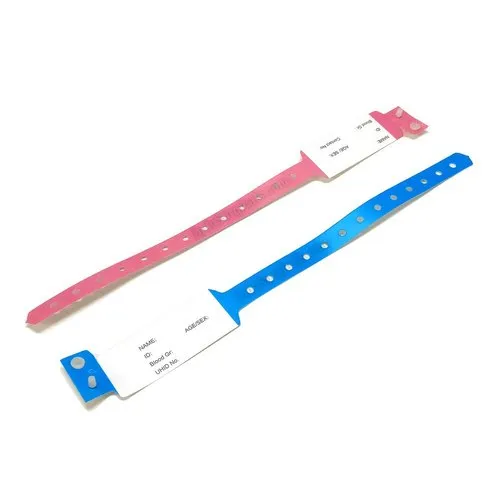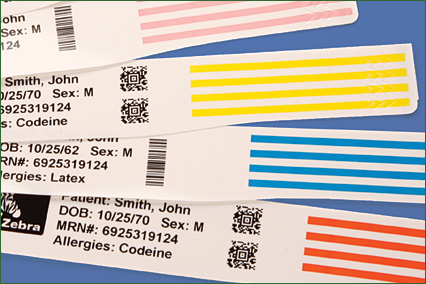Why Patient Identification Band is Crucial for Safe and Accurate Medical Care
Why Patient Identification Band is Crucial for Safe and Accurate Medical Care
Blog Article
Enhancing Patient Care With Reliable Identification Bands
The execution of effective identification bands is a crucial component in improving patient care within medical care settings. These bands not only offer to mitigate the threats related to client misidentification yet likewise streamline interaction amongst clinical employees, thereby promoting a more secure atmosphere. Different kinds of recognition bands provide to specific requirements, from durable wristbands for grownups to specialized bands for babies and critical cases. As the landscape of person identification develops, one need to consider the implications of these systems on general health care distribution and patient outcomes. What developments wait for in this essential area?
Relevance of Individual Recognition
Making sure exact person identification is essential in health care settings, as it directly impacts the safety and high quality of treatment offered. Misidentification can result in major mistakes, consisting of carrying out the wrong drug, executing inaccurate treatments, or miscommunicating crucial individual info. Such errors not just jeopardize client safety yet can additionally cause lawful ramifications and decreased count on in medical care systems.
Reliable patient identification is fundamental to establishing a protected setting where people obtain personalized and appropriate treatment. It assists in the accurate documents of clinical backgrounds, allergic reactions, and therapy plans, ensuring that doctor have accessibility to crucial info at all times. Robust identification procedures aid simplify interaction amongst medical personnel, enhancing collaboration and lowering the danger of mistakes.

Sorts Of Identification Bands
Recognition bands play a vital function in maintaining precise client documents and enhancing security within medical care atmospheres. Numerous types of recognition bands are utilized to deal with the certain demands and requirements of different client populaces.

An additional type is the ankle joint band, which is especially helpful for infants and infants, guaranteeing that identification continues to be intact even throughout treatment treatments. Specialty bands, such as those for allergic reaction signals or drop risk indicators, provide extra layers of safety and security by attracting immediate attention to essential individual conditions.
Just recently, digital identification bands have obtained popularity, including barcodes or RFID technology that can be checked to swiftly retrieve client information. These bands enhance process and decrease the risk of human mistake during individual recognition processes.
Advantages of Reliable Identification
Efficient recognition of patients with making use of identification bands contributes substantially to total client security and care quality. By making certain that each patient is properly determined, healthcare carriers can efficiently match medical therapies and procedures to the correct person, lessening the risk of errors. This is specifically crucial in environments with high individual turnover, where the capacity for misidentification is higher.
In addition, reliable my website identification bands boost communication among healthcare teams. Clear and precise patient identification cultivates collaboration and ensures that all employee are mindful of a person's specific needs and clinical background. This interaction is necessary for providing coordinated treatment, especially in emergency situations where time is crucial.

Eventually, reliable recognition through using identification bands not only safeguards clients yet also promotes a society of safety within medical care facilities (Patient Identification Band). By prioritizing exact recognition, medical care companies can boost outcomes and improve the overall patient experience
Carrying Out Identification Systems
While the significance of patient identification is well identified, the execution of durable identification systems positions a complex difficulty for health care companies. Establishing reliable recognition systems requires a comprehensive technique, incorporating innovation, employees training, and process integration.
First, organizations should choose suitable recognition modern technologies, such as barcode scanning, RFID, or biometric systems. Patient Identification Band. These technologies need to be assessed address based on price, use, and compatibility with existing framework. A pilot program can assist recognize potential issues before full-blown execution
Following, extensive training for staff is important. All workers need to recognize the significance of precise patient identification and excel in making use of the chosen modern technologies. Routine training updates and evaluations can enhance ideal practices and ensure ongoing compliance.
Furthermore, medical care organizations ought to develop standardized procedures for individual recognition across all departments, decreasing inconsistencies and enhancing communication. Regular audits can aid determine gaps in adherence to these procedures.

Eventually, a reliable implementation of recognition systems not only improves patient security yet likewise fosters a culture of responsibility and persistance within health care setups, ensuring constant and reputable client care.
Future Trends in Individual Recognition
Innovations in modern technology are established to reinvent individual recognition techniques in health care settings. The assimilation of biometric recognition approaches, such as fingerprinting and facial recognition, is expected to boost accuracy and safety and security. These technologies can dramatically decrease the danger of misidentification, ensuring that individuals receive the right treatments and medications.
Additionally, the implementation of blockchain modern technology for individual records is gaining grip. This decentralized method can give a safe and tamper-proof approach for managing individual identities, consequently streamlining access to critical info throughout different health care carriers.
An additional trend is the boosting usage of mobile health applications that utilize QR codes for individual recognition. These applications allow for real-time updates and simple accessibility to patient data, encouraging medical care professionals to make educated choices promptly.
Additionally, man-made knowledge (AI) is positioned to play a key function in evaluating individual recognition information, recognizing patterns, and forecasting possible recognition errors before they occur.
As these modern technologies advance, they promise not only to improve client security however likewise to improve the total performance of medical care distribution systems. Welcoming these innovations will be essential for future-proofing client treatment practices.
Final Thought
In final thought, reliable recognition bands are necessary for boosting individual security and care high quality within health care settings. By lessening the threats linked with misidentification, these bands facilitate accurate and prompt information retrieval, eventually enhancing communication among doctor. The application of robust recognition systems not just promotes a society of safety yet additionally settings healthcare institutions to adjust to future patterns in client recognition innovation, guaranteeing ideal outcomes for patients in varied clinical atmospheres.
As the landscape of client recognition evolves, one have to think about the implications of these systems on total health care distribution and individual outcomes.Efficient client recognition is basic moved here to developing a secure environment where individuals receive personalized and proper care. Eventually, prioritizing efficient client identification methods not just promotes a culture of safety but additionally contributes to boosted patient results and total satisfaction with medical care solutions.
Effective recognition of people through the usage of identification bands adds significantly to general patient security and care top quality. The implementation of robust recognition systems not just cultivates a culture of safety and security yet additionally placements medical care institutions to adapt to future fads in patient identification innovation, making sure optimum outcomes for clients in varied professional environments.
Report this page